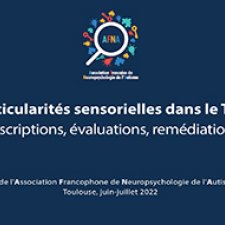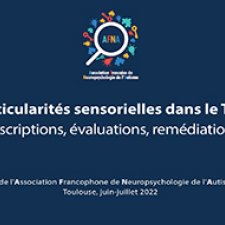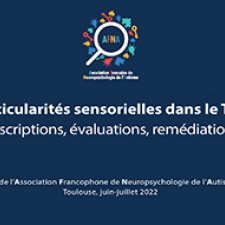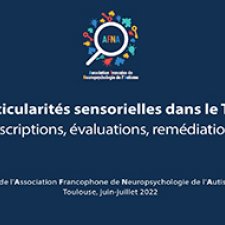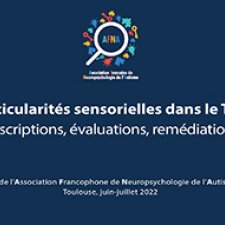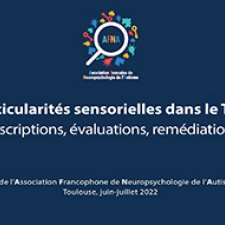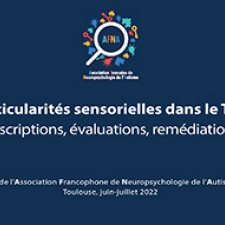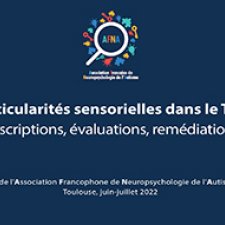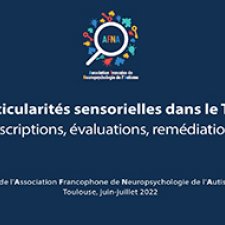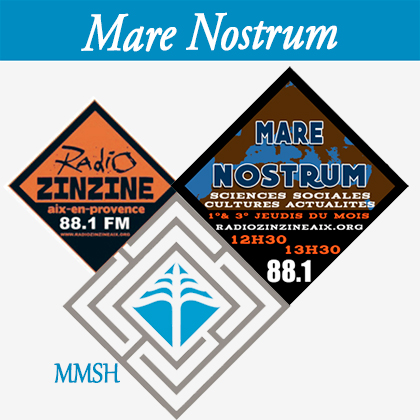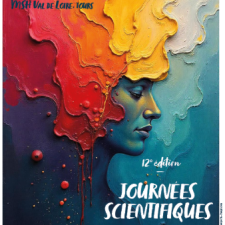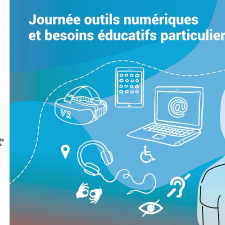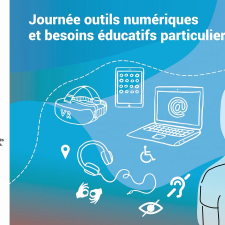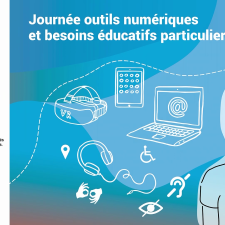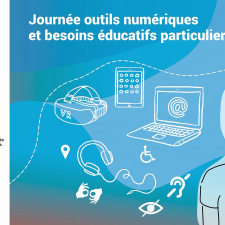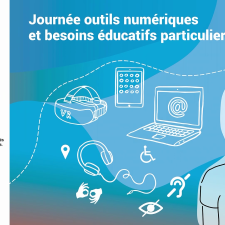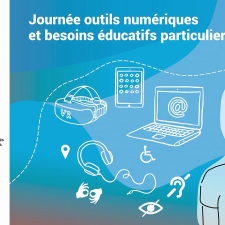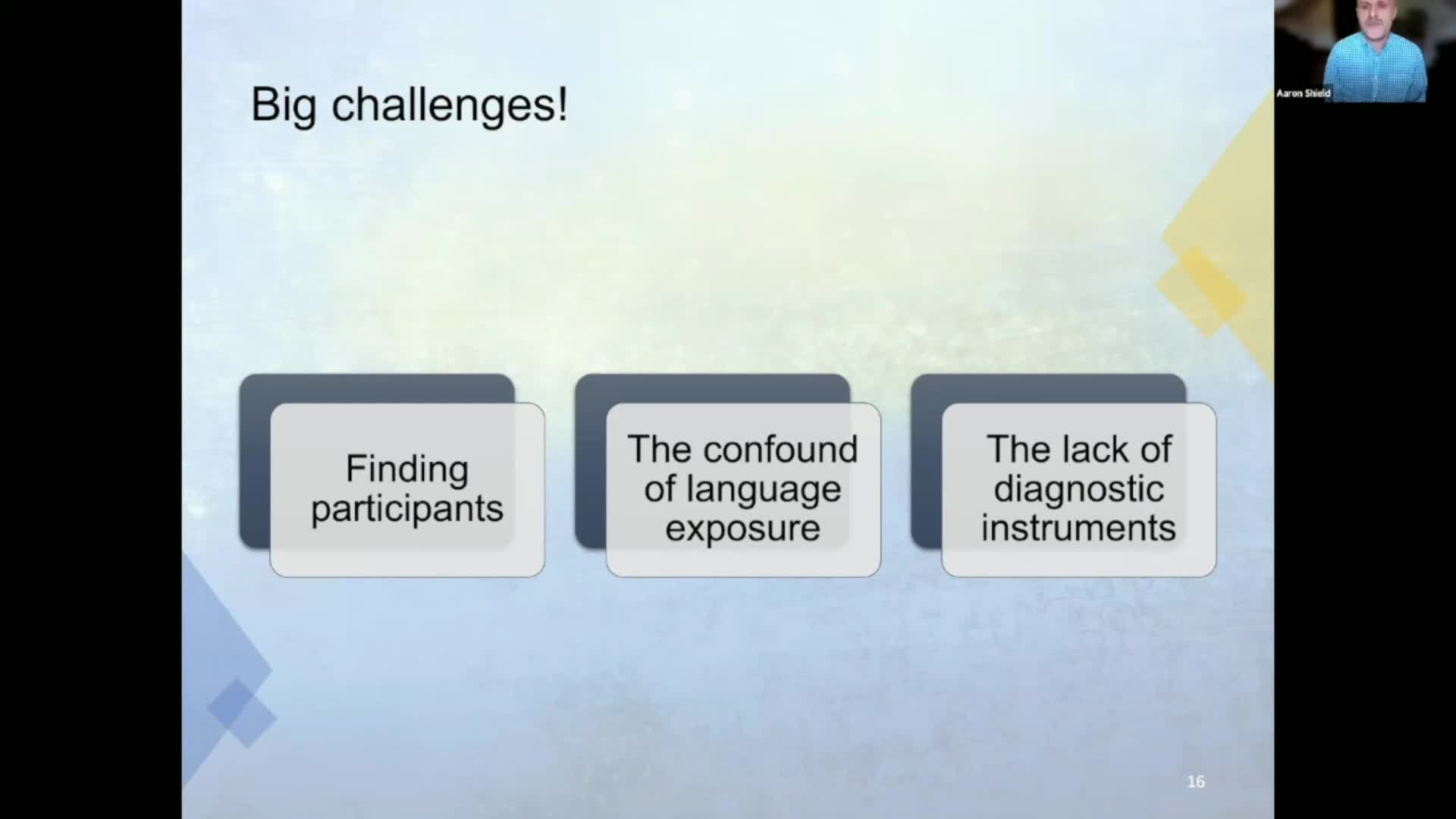Chapitres
Notice
Traitements sensoriels et fonctions neuropsychologiques. Les particularités féminines / Jeanne Kruck, Émilie Bork
- document 1 document 2 document 3
- niveau 1 niveau 2 niveau 3
Descriptif
Traitements sensoriels et fonctions neuropsychologiques. Les particularités féminines / Jeanne Kruck, Émilie Bork, in Particularités sensorielles dans le TSA : descriptions, évaluations, remédiations, 3e colloque de l'Association Francophone de Neuropsychologie de l’Autisme, organisé sous la responsabilité scientifique de Magali Batty (CERPPS, Univ. Toulouse), Éric Bizet (Univ. Strasbourg), Véronique Bonnaud (Univ. Poitiers) et Patrice Gillet (Univ. Tours). Université Toulouse-Jean Jaurès, 30 juin-1er juillet 2022.
Les particularités sensorielles qui accompagnent le Trouble du Spectre de l’Autisme (TSA) ont des répercussions importantes sur l’adaptation des personnes avec TSA, enfants et adultes, aux stimulations de l’environnement. D’où, l’intérêt d’en décrire les caractéristiques neuropsychologiques pour mieux comprendre leurs répercussions sur les fonctions cognitives, attentionnelles, mnésiques, socio-émotionnelles et envisager des approches de remédiation ajustées.
Discipline : Psychopathologie développementale
Mots clés : Trouble du spectre de l’autisme ; Caractéristiques féminines ; Traitement sensoriel ; Fonctions exécutives
Intervention / Responsable scientifique
Thème
Documentation
Bibliographie
BITSIKA, Vicki, SHARPLEY, Christopher F., MILLS, Richard (2021). Associations between sensory processing and depression in autistic girls, Research in Autism Spectrum Disorders, vol. 89, art. 101881.
OSÓRIO, Joana Maria Almeida, RODRÍGUEZ‐HERREROS, Borja, RICHETIN, Sonia, et al. (2021). Sex differences in sensory processing in children with autism spectrum disorder, Autism Research, 2021, vol. 14, no 11, p. 2412-2423. [En ligne : https://onlinelibrary.wiley.com/doi/epdf/10.1002/aur.2580].
TALCER, Moyna Catherine, DUFFY, Orla, PEDLOW, Katy (2021). A qualitative exploration into the sensory experiences of autistic mothers, Journal of Autism and Developmental Disorders, 1-16. [En ligne : https://link.springer.com/content/pdf/10.1007/s10803-021-05188-1.pdf].
TAYLOR, Emily, HOLT, Rosemary, TAVASSOLI, Teresa, et al. (2020). Revised scored Sensory Perception Quotient reveals sensory hypersensitivity in women with autism, Molecular autism, 1, vol. 11, 1-13. [En ligne : https://link.springer.com/article/10.1186/s13229-019-0289-x].
DELL’ARMI, Mélina, KRUCK, Jeanne, ROGÉ, Bernadette (2019). Identification des besoins familiaux des mères d’enfants ayant un trouble du spectre de l’autisme (Chapitre 6), in Cyrielle Derguy, Émilie Cappe (dirs), Familles et trouble du spectre de l'autisme. Paris, Éditions Dunod, 91-104.
MILNER, Victoria, MCINTOSH, Hollie, COLVERT, Emma, et al. (2019). A qualitative exploration of the female experience of autism spectrum disorder (ASD), Journal of autism and developmental disorders, 6, vol. 49, 2389-2402. [En ligne : https://link.springer.com/article/10.1007/s10803-019-03906-4].
PARK, Carolin, et al. (2019). Stress, epigenetics and depression: A systematic review, Neuroscience & Behavioral Review, 102, 139-152.
SAPEY-TRIOMPHE, Laurie-Anne, MOULIN, Annie, SONIÉ, Sandrine, et al. (2018). The Glasgow Sensory Questionnaire: validation of a French language version and refinement of sensory profiles of people with high autism-spectrum quotient, Journal of Autism and Developmental Disorders, 5, vol. 48, 1549-1565. [En ligne : https://www.researchgate.net/publication/321388929].
GOULD, Judith (2017). Towards understanding the under-recognition of girls and women on the autism spectrum. Autism, 21 (6), 703-705.
SERAFINI, Gianluca, GONDA, Xenia, et al. (2017). Extreme sensory processing patterns show a complex association with depression, and impulsivity, alexithymia, and hopelessness, Journal of Affective Disorders, 210, 249-257. [En ligne : https://core.ac.uk/download/83096840.pdf].
GAUDELUS, Baptiste, VIRGILE, Jefferson, GELIOT, Sabrina, et al. (2016). Improving facial emotion recognition in schizophrenia: a controlled study comparing specific and attentional focused cognitive remediation, Frontiers in psychiatry, vol. 7, art. 105. [En ligne : https://www.frontiersin.org/articles/10.3389/fpsyt.2016.00105/full].
ROTH, Robert M., ISQUITH, Peter K., GIOIA, Gérard A. (2015). BRIEF-A: inventaire d'évaluation comportementale des fonctions exécutives-version adulte. Paris, Éditions Hogrefe France.
JACQUEMONT, S. et al. (2014). A Higher Mutational Burden in Females Supports a “Female Protective Model” in Neurodevelopmental Disorders. The American Journal of Human Genetics, 3, vol. 94, 415-425. [En ligne : https://www.cell.com/ajhg/fulltext/S0002-9297(14)00059-7].
KREISER, Nicole, WHITE, Susan (2014). ASD in Females: Are We Overstating the Gender Difference in Diagnosis?, Clinical Child and Family Psychology Review, 1, vol. 17, 67-84. [En ligne : https://www.researchgate.net/publication/247772263].
LAI, Meng Chuan, LOMBARDO, Michael, PASCO, Greg, et al. (2011) A Behavioral Comparison of Male and Female Adults with High Functioning Autism Spectrum Conditions, PLoSONE, 6, vol. 6, art. e20835. [En ligne : https://journals.plos.org/plosone/article?id=10.1371/journal.pone.0020835].
Liens
Site de l’AFNA : https://afna2017.wordpress.com/
Dans la même collection
-
Introduction au colloque. Particularités sensorielles, de Kanner à aujourd’hui / Bernadette Rogé
RogéBernadetteLes particularités sensorielles qui accompagnent le Trouble du Spectre de l’Autisme (TSA) ont des répercussions importantes sur l’adaptation des personnes avec TSA, enfants et adultes, aux
-
De l’observation à l’expérimentation : l’autisme interroge la neurophysiologie
BarthélémyCatherineLes particularités sensorielles qui accompagnent le Trouble du Spectre de l’Autisme (TSA) ont des répercussions importantes sur l’adaptation des personnes avec TSA, enfants et adultes, aux
-
Processus prédictifs et perception particulière dans l'autisme / Christina Schmitz
SchmitzChristinaLes particularités sensorielles qui accompagnent le Trouble du Spectre de l’Autisme (TSA) ont des répercussions importantes sur l’adaptation des personnes avec TSA, enfants et adultes, aux
-
L’intégration multimodale en autisme : une perspective développementale / Armando Bertone
BertoneArmandoLes particularités sensorielles qui accompagnent le Trouble du Spectre de l’Autisme (TSA) ont des répercussions importantes sur l’adaptation des personnes avec TSA, enfants et adultes, aux
-
Approche comparative des particularités sensorielles au sein des TND et introduction à l'évaluation…
TatonRomainDegenne-RichardClaireLes particularités sensorielles qui accompagnent le Trouble du Spectre de l’Autisme (TSA) ont des répercussions importantes sur l’adaptation des personnes avec TSA, enfants et adultes, aux
-
Comment les particularités perceptives influencent la cognition et les apprentissages ? / Isabelle …
SoulièresIsabelleLes particularités sensorielles qui accompagnent le Trouble du Spectre de l’Autisme (TSA) ont des répercussions importantes sur l’adaptation des personnes avec TSA, enfants et adultes, aux
-
Évaluation d'une pensée visuelle dans l'autisme / Lucie Bouvet, Clara Bled
BouvetLucieBledClaraLes particularités sensorielles qui accompagnent le Trouble du Spectre de l’Autisme (TSA) ont des répercussions importantes sur l’adaptation des personnes avec TSA, enfants et adultes, aux
-
Évaluation des signes sensori‐psychomoteurs dans l'autisme : différentiation et évolution des profi…
Le Menn-TripiCindyLes particularités sensorielles qui accompagnent le Trouble du Spectre de l’Autisme (TSA) ont des répercussions importantes sur l’adaptation des personnes avec TSA, enfants et adultes, aux
-
Perception visuelle et lecture des émotions : rôle de l'orthoptie neuro-visuelle / Marie-Laure Labo…
LaborieMarie-LaureLes particularités sensorielles qui accompagnent le Trouble du Spectre de l’Autisme (TSA) ont des répercussions importantes sur l’adaptation des personnes avec TSA, enfants et adultes, aux
-
Expérimentation de la réalité virtuelle immersive pour entrainer les capacités de traitement multis…
ClaireRémiRoulEmmanuelLes particularités sensorielles qui accompagnent le Trouble du Spectre de l’Autisme (TSA) ont des répercussions importantes sur l’adaptation des personnes avec TSA, enfants et adultes, aux
Sur le même thème
-
Les femmes de la noblesse du sud de la France et l’écriture
CaparosCamilleÀ l’époque moderne commencent à apparaître des documents écrits par les femmes. Jusque-là, cette pratique était peu courante soit à cause d’une éducation peu encouragée, voire absente soit à cause d
-
Les femmes dans la Résistance
À l’occasion de ce moment important où l’on se doit de célébrer et de promouvoir les droits des femmes, et en particulier le droit à l’égalité dans tous les domaines avec les hommes, principe majeur d
-
DEV-IA : Développement d’un modèle intégratif et transdiagnostique en psychopathologie basé sur un…
CourtoisRobertSelon l’OMS, 1 personne sur 8 souffrirait de troubles mentaux. Pour y remédier, de nombreux traitements psychologiques ont été mis au point. Cependant, ceux-ci ont été construits d’une part en
-
Synthèse des travaux de recherches sur les espaces virtuels
MagotClaude-AlexandreSynthèse des travaux de recherches sur les espaces virtuels
-
-
-
-
-
Ouverture de la journée Outils numériques et besoins éducatifs particuliers
MauguinMurielleGarnierPhilippeOuverture de la journée Outils numériques et besoins éducatifs particuliers
-
Exposition à une langue des signes de personnes avec troubles du spectre de l’autisme : bilan des r…
ShieldAaronVanbruggheAnneCruveillerVirginieGérardChristelleJournée d’études sur les thèmes associés de la langue des signes française (LSF) et des troubles du spectre de l’autisme (TSA), dans le cadre d’une recherche en cours sur les interactions gestuelles,
-
Les JDG, le bilan psychomoteur adapté aux enfants présentant un Trouble du Spectre de l'Autisme - L…
Les JDG - 6 janvier 2023 Le bilan psychomoteur adapté aux enfants présentant un Trouble du Spectre de l’Autisme – Les pistes d’accompagnement. Intervenante : M. Allanore, psychomotricienne
-
Introduction au colloque. Particularités sensorielles, de Kanner à aujourd’hui / Bernadette Rogé
RogéBernadetteLes particularités sensorielles qui accompagnent le Trouble du Spectre de l’Autisme (TSA) ont des répercussions importantes sur l’adaptation des personnes avec TSA, enfants et adultes, aux



